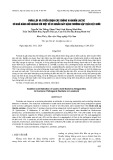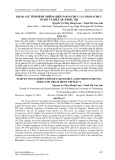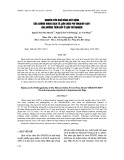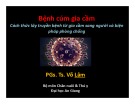
Int.J.Curr.Microbiol.App.Sci (2020) 9(11): 1884-1892
1884
Original Research Article https://doi.org/10.20546/ijcmas.2020.911.223
Isolation, Identification and Molecular Detection of Zoonotic
Campylobacter jejuni Isolated from Mutton and Beef Samples
Sumedha Bobade*, K. Vijayarani, K. G. Tirumurugaan,
A. Thangavelu and S. Vairamuthu
Department of Animal Biotechnology, Madras Veterinary College,
TANUVAS, Chennai (Tamil Nadu), India
*Corresponding author
A B S T R A C T
Introduction
The pathogenesis of C. jejuni is poorly
understood as compared to other enteric
pathogens (Rizal et al., 2010). Cattle are a
major source of food and the cattle industry
engages people from farms to processing
plants and meat markets, it is plausible that
beef-products contaminated with
Campylobacter spp. would pose a significant
public health concern (Sanad et al., 2011).
The sudden onset of fever, abdominal cramps,
and diarrhoea with blood and leukocytes are
characteristics of C. jejuni infection (Kim et
al., 2015). Campylobacter spp. can be
transferred from animals to humans by
contaminated food of animal origin. Chicken
has been recognized as a major source for
International Journal of Current Microbiology and Applied Sciences
ISSN: 2319-7706 Volume 9 Number 11 (2020)
Journal homepage: http://www.ijcmas.com
Campylobacter species are a leading cause of food-borne disease and C. jejuni highlight
the most potential public health impact of Campylobacter contamination by pathogens
originating from animals or animal products.. The total of 33meat samples comprising 8
from sheep (5) and goat (3) also 25 beef samples were screened by morphological,
biochemical and molecular technique. The isolates were subjected to phenotypic
characterization using biochemical test and genotypic characterization. The isolates from
chevon (3 out of 3) and mutton (2 out of 5) were positive for morphological and
biochemical examination. The 20 (80%) beef samples were found to be positive by
morphological examination and 12(48%) isolates showed biochemical reactions positive
for C.jejuni. The isolates were subjected to PCR targeting hip O and MAP A genes. The
result showed 66.66 % from chevon, 20% mutton and 20% isolates from beef samples
were found to be positive for C.jejuni. These findings suggest that PCR should be the
preferred diagnostic method for detection of Campylobacter in livestock. The good
hygienic and manufacturing practices must be followed in the entire food chain to prevent
the contamination of food due to microbe which can cause Campylobacteriosis among the
consumers.
K e y w o r d s
CCDA, Hip O,
MAP, Hippurate,
C. jejuni
Accepted:
12 October 2020
Available Online:
10 November 2020
Article Info

Int.J.Curr.Microbiol.App.Sci (2020) 9(11): 1884-1892
1885
human infection, whereas cattle might also
contribute to a lesser extent. Cattle is the
second major reservoir for C. jejuni (Jonas et
al., 2015). The consumption of contaminated
meat and meat products are responsible for
more than 90% of human infections caused by
Campylobacter jejuni (Mikulic et al., 2016).
Campylobacteris considered as a principal
cause of most important zoonotic food-borne
disease in humans for approximately 166
million diarrheal cases and globally 37,600
deaths per year (Oh et al., 2018).
In humans, clinical signs of
Campylobacteriosis include diarrhea,
abdominal pain, fever, headache, nausea and
vomiting. Most of Campylobacter are
sporadic and self-limiting, The main
recognized sequelae are Guillain-Barré
Syndrome (GBS), the Reactive Arthritis
(REA) and irritable bowel syndrome (IBS).
Thermo tolerant Campylobacter which has a
clinical significance due to the consumption
of meat and meat products are C. jejuni and
its closely connected (Mikulic et al., 2016).
For more than three decades Campylobacter
is pathogen-related causes and significant
factor of diarrheal illnesses in human
(Magana et al., 2017). This zoonotic infection
is of great public health concern, with meats
known as the major risk factor (Carron et al.,
2018). Campylobacter spp. is a zoonotic
bacterium and cause of human gastroenteritis
worldwide and main symptom is diarrhea
(Hlashwayo et al., 2020).
Campylobacter is difficult to isolate, grow
and identify. Only Campylobacter jejuni can
be routinely identified with phenotypic
markers, and commercial systems may
misidentify non-jejuni species (Fitzgerald et
al., 2016). Campylobacter poses an important
risk for humans through shedding of the
pathogen in livestock waste and
contamination of water sources, environment,
and food by colonization of different animal
reservoirs (Gahamanyi et al., 2020). The
reservoir and source of human
campylobacteriosis is primarily considered to
be poultry, but also other such as ruminants,
pets and environmental sources are related
with infection burden (Maesaar et al.,
2020).There is a high incidence of
Campylobacter species in meat carcasses,
suggesting these to be a reservoir of
Campylobacteriosis agents, and consumption
of undercooked meats is a potential health
risk to consumers (Igwaran and Okoh, 2020).
The major transmission routes of
Campylobacteriosis in humans are
consumption of contaminated or undercooked
meat. Despite the size of the livestock and
meat industry in India, little is known about
the Campylobacteriosis as zoonotic foodborne
pathogen. Hence this study was attempted to
detect the presence of C. jejuni using
morphological, biochemical and PCR
technique and compare these techniques for
detection among different sources from
animal origin.
Materials and Methods
Collection of samples
A total of (8) meat sample of Sheep (5) and
Goat (3) meat collected from retail outlet and
beef (25) samples from slaughter house were
collected using sterile containers and
transported immediately to the laboratory
under cold conditions for microbiological
analysis.
Processing of samples
The isolation was performed according to
Man (2011) and the isolates were identified
by biochemical tests as described by
(Fitzgerald and Nachamkin, 2007 and
Lastovica and Allos, 2008). The reference
strain Campylobacter jejuni (ATCC33291)
was used as standard for PCR.

Int.J.Curr.Microbiol.App.Sci (2020) 9(11): 1884-1892
1886
Phenotypic characterization
Morphological examination
Sample was enriched in modified Charcoal
Cefoperazone Deoxycholate (mCCDA) broth
(Hutchinson and Bolton, 1984) with CCDA
supplement (FD 135) under microaerophillic
conditions (candle jar method) by using
internal gas generation system using
(Microaerophilic gas pack CampyPack-BD
oxoid).
Biochemical test
The isolates were identified based on their
morphological and biochemical tests
.Suspected colonies were sub-cultured and
confirmed by catalase, oxidase, nitrate and
hippurate hydrolysis, Ninhydrintest, H2S
production for confirmation as C. jejuni.
Molecular confirmation of Campylobacter
jejuni
The biochemically identified isolates were
further employed for molecular confirmation
as C. jejuni by polymerase chain reaction
amplifying specific target gene using species-
specific oligonucleotide primers. DNA was
extracted by Phenol-Chloroform extraction
method and the DNA concentration was
quantified by nanodrop and stored at -20°C
until further processing.
Genotypic confirmation of isolates by
polymerase chain reaction for Hip O gene
and MAP Agene
Polymerase chain reaction was carried out
using primers for species specific genes. The
PCR was performed in a thermal cycler
(Applied Biosystem). The hipO gene region is
the hippuricase gene, specific for C. jejuni.
Primers for hipO gene specific identification
were designed using the gene sequences of
C.jejuni based on the sequences available in
the GenBank. The isolates were confirmed by
PCR using designed primers in the study for
hipO gene as forward primer (5-
TTCCATGACCACCTCTTCC-3) and reverse
primer (5-CTACTTCTTTATTGCTTGCTGC
-3).
The primers used for amplification of MAP A
gene were forward primer (5-
CTATTTTATTTTTGAGTGCTTGTG-3) and
reverse primers (5-GCTTTATTTGCC
ATTTGTTTTATTA-3) (Khoshbakht et al.,
2015).
The PCR reactions were performed in 25 μl
reaction mixture, containing 12.5 μl PCR
master mix (2X-Ampliqon), 1μl of each
primer of a 10 μM primer concentration,1μl
MgCl2 (25mM), 3μl template DNA and 6.5 μl
nuclease-free water making a total volume of
25 μl. The amplification conditions consisted
of initial denaturation at 94 °C for 3 min, 35
cycles with denaturation at 94 °C for 1 min,
annealing at 53°C for HipO gene for 1 min,
and extension at 72 °C for 1 min, followed by
a final extension at 72 °C for 5 min
respectively (Al Amri et al., 2007) .The
annealing temperature for MapA gene was
optimized as 52 °C for 1 min (Khoshbakht et
al., 2015). The DNA from C. jejuni (ATCC
33291) was included as positive control for
PCR identification of the isolates and the
master mix without sample DNA used as
negative control. The amplified products were
observed and photographed using gel
documentation System (Applied Biosystems).
Results and Discussion
Campylobacter spp. is a major cause of
gastroenteritis, there is an urgent need to
control these pathogens with zoonotic and
public health point of view. The
Campylobacter species are difficult to isolate
but the results from inoculation studies

Int.J.Curr.Microbiol.App.Sci (2020) 9(11): 1884-1892
1887
showed that plates with charcoal had a better
recovery rate than other media used for
isolation. Modified blood free Charcoal
cefoperazone deoxycholate agar is commonly
used worldwide (Bolton et al., 1984;
Hutchinson and Bolton, 1984). In current
study all samples showed growth on mCCDA
agar plates. On selective agar, Blood free
modified charcoalcefoperazone deoxycholate
(mCCDA), colonies were found to be typical
grey/white or creamy grey in colour, smooth,
glistening, and convex with entire edges and
moist in appearance, dew drop with the
tendency to spread with sticky nature were
confirmed phenotypically as Campylobacter.
The suspected colonies were examined for
morphological characteristics, motility,
Gram’s staining. Campylobacter species are
Gram negative rods with characteristically
curved, spiral, or S-shaped cells. The overall
incidence of Campylobacter was found to be
(3 out of 3) in chevon and (2 out of 5) mutton
also 20 (80%) in beef by morphological
examination (Table 1 and 2).
Biochemical characterization
The isolates were processed for phenotypic
characterization and identified by biochemical
tests, viz. oxidase, catalase, indoxyl acetate
hydrolysis tests and H2S production in triple
sugar iron test. In current investigation of
eight samples from mutton and chevon
processed five isolates showed positive
reaction for all biochemical test. The Twelve
isolates from beef sampled showed positive
reaction for biochemical tests and tentatively
confirmed as Campylobacter. The test for
hippurate hydrolysis is critical for separation
of Campylobacter jejuni and C. coli strains.
Glycine and benzoic acid are formed when
hippurate is hydrolyzed by C. jejuni (Morris
et al., 1985). Out of the 46 isolates screened,
33 were found positive for hippurate
hydrolysis and were classified as C. jejuni
(Kumar et al., 2015). In current study 5
isolates from chevon and mutton and 12
isolates from beef were confirmed as C.jejuni
on basis of hippurate hydrolysis test.
Two samples from chevon and one from beef
were positive for H2S production. The most of
the samples were negative for H2S production
C. jejuni biotype 2 strains are H2S positive,
whereas C. jejuni biotype 1 strains are H2S
negative (Penner, 1988).In this studythree
isolates were positive for H2S production
belong to biotyope 2 while 14belong to
biotype 1 of C.jejuni.
Genotypic characterization
The isolates were confirmed by polymerase
chain with species specific primers for HIP O
and MAP A gene. The size of PCR product for
Hip O gene was 270 bp and the size of the
PCR product for MAP A gene was 589 bp.
Three isolates (two from chevon and one from
mutton) as well as five from beef samples
showed specific amplification and confirmed
as C.jejuni.
Incidence of Campylobacter jejuni in
chevon mutton and beef
Among meat samples processed, the
prevalence of Campylobacter was recorded in
raw beef (10.9%) and raw mutton (5.1%). The
study reported that the prevalence of
Campylobacter spp. was significantly higher
in the food commodities, which included
raw/undercooked ingredients (Hussai et al.,
2007). A total of 183chevon, and 42 carabeef
were processed and samples showed
characteristic colonies on mCCDA plates.
The prevalence rate of 7.6% was recorded in
chevon. None of the isolates were recovered
from beef samples. Most of the obtained
isolates were classified as C. jejuni indicating
that the C. jejuni was the most commonly
found species while in current study five beef
samples were confirmed as C. jejuni. The 183

Int.J.Curr.Microbiol.App.Sci (2020) 9(11): 1884-1892
1888
chevon samples processed, 14 (7.6%) were
reported as Campylobacter 10 were identified
to be C. jejuni through molecular means
(Monika et al., 2016), while in our study, 5
(62.5%) from muton and chevon samples
were found to be positive by molecular
identification using species specific primer.
Among the 853 livestock faecal samples,
Campylobacter were detected by culture in
106 samples (12%); 72 samples (68%) tested
positive for C. jejuni (Osbjer et al., 2016). A
total of Mutton (n=100) samples were
collected from different open markets of
Kolkata cityCampylobacter spp. was detected
64% of mutton meat samples. The most
prevalent species recovered from samples was
Campylobacter jejuni with 58.8% of the
isolates confirmed (Sharma et al., 2016) while
lower incidence was recorded from this study.
Rahimi et al., (2010) conducted a study to
determine the prevalence of Campylobacter
spp. isolated from retail raw meats in Iran. A
total of (n = 190) beef, (n = 225) lamb, and (n
= 180) goat raw meat samples were purchased
from randomly selected retail outlets and
were evaluated for the presence of
Campylobacter spp. The highest prevalence
of Campylobacter spp. was found in lamb
meat (12.0%), followed by goat meat (9.4%),
beef meat (2.4%). The most prevalent
Campylobacter spp. isolated from the meat
samples was Campylobacter jejuni (84.0%) in
accordance with current study. A total of 200
samples consisting of 100 meat and 100 liver
surface swabs were collected from 47 lamb
and 53 goat kid carcasses at 23 retail markets
in Northern Greece and 125 Campylobacter
isolates were recovered from 32 meat surfaces
(32%) and 44 liver surfaces (44%) and C.
jejuni (40.8%) detected species by multiplex
polymerase chain reaction (Lazou et al.,
2014).The overall prevalence of
Campylobacter in different sample groups
was 41.2%, 37.2%,23.7%, and 35.1% for goat
meat, goat stomachs, RTE goat skewers, and
goat faecal samples, respectively. C. jejuni
was isolated in 10.1% samples (Mpalang et
al., 2014). Pallavi and Kumar (2014) studied
the prevalence of Campylobacter species in
foods of animal origin. A total of 50 chevon
were collected from retail meat markets,
slaughter houses and analyzed for isolation
biochemical characterization and confirmed
by polymerase chain reaction. The prevalence
of Campylobacter spp. in chevon 6% was
observed while in current study highest
incidence rate was observed.
The study to isolate and detect Campylobacter
species in meat samples, including mutton
offals, beef, beef offals the samples were
subjected to both traditional culture on
modified charcoal cefoperazone deoxycholate
agar (mCCDA) plates and PCR techniques.
From culture, a total of 845 presumptive
isolates were obtained, of which 28.40%
(208/845) were identified as 32.5% (208/640)
were obtained from retail markets, 15.17%
(22/145) from butcheries, and 16.67% (10/60)
from open markets. Campylobacter
presumptive isolates from mutton sample 4
(44.44%) and 30 (33.71%) from beef were
identified as genus Campylobacter. These
were then characterised into species level, of
which the prevalence rate of C. jejuni was
observed (16.66%) (Igwaran and Okoh,
2020). Campylobacter detection and
prevalence calculations estimate in 17.8%
(95% CI 12.6-24.5) of 2907 goat samples;
12.6% (95% CI 8.4-18.5) of 2382 sheep
samples; and 12.3% (95% CI 9.5-15.8) of
6545 cattle samples suggested that meat and
organs were significantly less likely to be
contaminated than gut samples (Thomas et
al., 2020).The overall prevalence of
Campylobacter for ovine trim based on PCR-
detection was 33% (39 out of 120 samples)
with prevalence for hogget, lamb and mutton
carcass trim of 56% (28out of 50), 11% (4 out
of 35) and 20% (7 out of 35), respectively
(Rivas et al., 2020) in conformity with our
study (Fig. 1).

![Bệnh trên bò: Tài liệu một số bệnh thường gặp [A-Z]](https://cdn.tailieu.vn/images/document/thumbnail/2025/20250726/kimphuong1001/135x160/9451753499042.jpg)
























